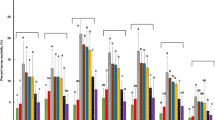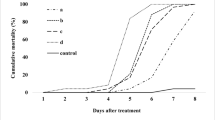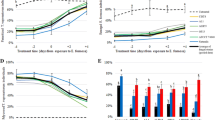Abstract
Several strains of Hyphomycetes fungi were assayed in the laboratory to determine their pathogenicity against second instar Chilo partellus Swinhoe larvae and fifth-sixth instar Busseola fusca Fuller larvae. Pathogenic activity to both stem borers was demonstrated with Beauveria bassiana (Balsamo) Vuillemin and Metarhizium anisopliae (Metschnikoff) Sorokin. B. bassiana isolates caused mortality of 3–100% of mortality in C. partellus larvae, and 30-84% in B.fusca. Strains of M.anisopliae showed a high level of virulence for both insect pests, causing mortality levels of 65–100%. Development of fungal infection appeared to take longer in B. fusca larvae (LT50 of 6.2–13.2 days) than in C. partellus (LT50 of 1.9–5.4 days). B. bassiana isolate ICIPE 4, and M. anisopliae isolates ICIPE 18 and 30, which were effective against both stem borers, outperformed the other pathogens tested. They appear to have potential for use asmicrobial agents in the control of C. partellus and B. fusca.
Résumé
Plusieurs souches d’Hyphom ycètes entomopathogènes ont été testées au laboratoire pour déterminer leur pathogénicité a l’égard des larves du 2nd stade de Chilo partellus Swinhoe et celles du 5-6ème stade de Busseola fusca Fuller. L’activité pathogène sur les 2 foreurs a été demontrée avec l’espèce Beauveria bassiana (Balsamo) Vuillemin et Metarhizium anisopliae (Metschnikoff) Sorokin. Mais, l’aptitude à infecter et à causer la mort des insecte-hôtes varie suivant les souches d’une espèce fongique. Ainsi, les isolats de B. bassiana provoquent une mortalité de 3 à100% chez les larves de C. partellus, et de 30 à 84% parmi celles de B. fusca. Cependant, les souches de M. anisopliae induisent une mortalité élevée chez les 2 insectes; celle-ci étant comprise entre 65 et 100%. Le temps d’incubation de la maladie paraît plus longue chez les larves de B. fusca (TL50 entre 6, 2 et 13, 2 jours) que chez celles de C. partellus (TL50 entre 1, 9 et 5, 4 jours). L’isolat de B. bassiana ICIPE 4 et les isolats de M. anisopliae ICIPE 18 et 30, se sont montrés plus pathogènes que les autres isolats pour les larves des 2 foreurs. Par consequent, ils présentent des potentialités pour la lutte biologique.
Similar content being viewed by others
References
Abbott W. S. (1925) A method of computing the effectiveness of an insecticide. J. econ. Entomol. 18, 265–267.
Boucias D. G., Bradford D. L. and Barfield C. S. (1984) Susceptibility of the velvetbean caterpillar and soybean looper (Lepidoptera: Noctuidae) to Nomuraea rileyi: effects of pathotype, dosage, temperatures, and host age. J. econ. Entomol. 77, 247–253.
Easwaramoorthy S. and Santhalakshmi G. (1987) Occurrence of a fungal disease on sugar-cane shoot borer, Chilo infuscatellus Snell. Entomon 12, 394.
Fargues J. (1976) Spécificité des champignons pathogènes imparfaits (Hyphomycètes) pour les larves de Coléoptères (Scarabaeidae et Chrysomelidae). Entomophaga 21, 313–323.
Fargues J. and Remaudière G. (1977) Consideration on the specificity of entomopathogenic fungi. Mycopathologia 62, 31–37.
Fargues J. and Rodriguez-Rueda D. (1980) Sensibilité des larves de Spodoptera littoralis (Lép.: Noctuidae) aux hyphomycètes entomopathogènes Nomuraea rileyi et Paecilomyces fumosoroseus. Entomophaga 25, 43–54.
Ferron P., Hurpin B. and Robert P. H. (1972) Sur la specificite de Metarhizium anisopliae (Metsch.) Sorokin. Entomophaga 17, 165–178.
Getzin L. W. (1961) Spicaria rileyi (Farlow) Charles, an entomogenous fungus of Trichoplusia ni (Hubner). J. Invertebr. Pathol. 3, 2–10.
Hall R.A. and Papierok B. (1982) Fungi as biological agents of arthropods of agricultural and medical importance. Parasitology 84, 205–240.
Hamburg H. van (1980) The grain sorghum stalk-borer, Chilo partellus (Lepidoptera: Pyralidae): Survival and location of larvae at different infestation levels in plants of different ages. J. Entomol. Soc. Sth Afr. 43, 71–76.
Hussey N. W. and Tinsley T. W. (1981) Impressions of insect pathology in the People’s Republic of China. In Microbial Control of Pests and Plant Diseases 1970-1980 (Edited by Burges H. D.), pp. 785–795. Academic Press, New York.
Ignoffo C. M. (1981) The fungus Nomuraea rileyi as a microbial insecticide. In Microbial Control of Pests and Plant Diseases 1970-1980 (Edited by Burges H. D.), pp. 513–538. Academic Press, New York.
Maniania N. K. and Fargues J. (1984) Spécificitédes Hyphomycètes entomopathogènes pour lcs larves de lépidoptères Noctuidae. Entomophaga 29, 451–464.
Maniania N. K. and Fargues J. (1985) Susceptibility of the fall armyworm, Spodoptera frugiperda, to the fungal pathogens Paecilomyces fumosoroseus and Nomuraea rileyi. Fla. Entomol. 68, 178–183.
Mohamed A. K. A, Sikorowski P. and Bell J. V. (1977) The susceptibility of Heliolhis zea larvae to Nomuraea rileyi at various temperatures. J. Invertebr. Pathol. 12, 444–459.
N’doye M. (1977) Sensibilité à divers champignons entomopathogènes (Fungi Imperfecti) et déterminisme de la mycose à Beauveria bassiana (Bals.) Vuill. chez les chenilles et chrysalides de Chilo suppressalis Walker. Bull, de l’Inst. Fondamental d’Afr. Noire 39, 303–317.
Nye I. W. B (1960) The insect pests of graminaceous crops in East Africa. Col. Res. Studies No. 31, H.M.S.O., London.
Ochieng R. S., Onyango F. O. and Bungu M. D. O (1985) Improvement of techniques for mass culture of Chilo partellus (Swinhoe). insect Sci. Applic. 6, 425-28.
Odindo M. O., Otieno W. A., Oloo G. W., Kilori J. and Odhiambo R. C. (1989) Prevalence of microorganisms in field-sampled borers on sorghum, maize, and cowpea in Western Kenya. Insect Sci. Applic. 10, 225–228.
Riba G. (1985) Contribution à l’éiude génétique de quelques hyphomycètcs entomopathogènes. Thèse Doctorat es Sciences Nalurelles. Univ. Paris.
Rombach M. C., Rombach G. M. and Roberts D. W. (1987) Pathogens of insect pests of rice: a bibliography. Insect Sci. Applic. 8, 197–210.
Steinhaus E. A. and Marsh G. A. (1962) Report of diagnosis of diseased insects 1951-1962. Hilgardia 33, 349–490.
Unnithan G. C. (1987) Development and reproductive biology of the maize stem borer Busseola fusca Fuller (Lepid., Noctuidae). J. Appl. Entomol. 104, 172–179.
Varma A. and Mitra K. (1981) Recent researches leading to evolve a suitable control programme for stalk borer, Chilo auricilius Dudg. Proc. Natn. Symp. Stalk Borer, Karnal pp. 63–65.
Young W. R. and Teetes G. L. (1977) Sorghum entomology. Annu. Rev. Entomol. 22, 193–219.
Zimmermann G. (1986) The “Galleria bait method” for detection of entomopathogenic fungi in soil. J. Appl. Entomol. 102, 213–215.
Author information
Authors and Affiliations
Rights and permissions
About this article
Cite this article
Maniania, N.K. Pathogenicity of Entomogenous Fungi (Hyphomycetes) to Larvae of the Stem Borers, Chilo Partellus Swinhoe and Busseola Fusca Fuller. Int J Trop Insect Sci 13, 691–696 (1992). https://doi.org/10.1017/S1742758400007918
Received:
Revised:
Published:
Issue Date:
DOI: https://doi.org/10.1017/S1742758400007918
Key Words
- Pathogenicity
- entomogenous fungi
- Hyphomycetes
- strains
- stem borers
- larvae
- Chilo partellus
- Busseola fusca
- bioassays




